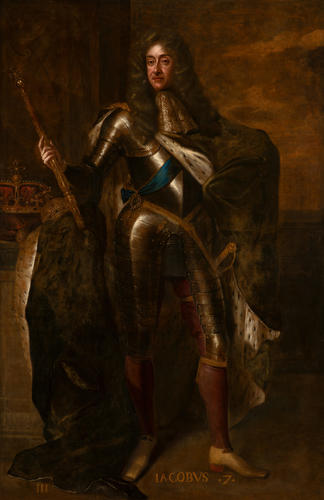Jacob Jacobsz de Wet II (Haarlem 1641/2 - Amsterdam 1697)
James VII & II, King of Great Britain (1685-8) 1684-86
Oil on canvas | 214.0 x 137.0 cm (support, canvas/panel/stretcher external) | RCIN 403313
Great Gallery, Palace of Holyroodhouse
-
Upon the death of Charles II in 1685, James VII & II became King of Great Britain. Lacking his brother’s political shrewdness, James favoured absolutism and was openly Catholic. This proved his downfall: at the climax of discontent with his rule, a group of seven Protestant nobles invited the Dutch Stadtholder William of Orange to invade England; his wife was Charles I’s granddaughter Mary, giving him a legitimate claim to the British throne. In 1689 James fled England to the court of the French king Louis XIV, dying in exile at the Palace of Saint-Germain-en-Laye. The figure of James VII is copied directly from a state portrait by Godfrey Kneller showing the king in armour, a prime version of which is held by the National Portrait Gallery (NPG 666). It was commissioned separately from the rest of the series after the death of Charles II, for the sum of £30 sterling (this payment also covered the execution of RCIN 401240). James resided in Holyrood as the King’s High Commissioner from 1680 during the Exclusion Crisis. At this time he may have been involved in commissioning the de Wet series. The Dutch artist Jacob de Wet II was first brought to Edinburgh in 1673 by Sir William Bruce, King’s Surveyor and Master of Works in Scotland. As part of a team of skilled British and foreign craftsmen working at the Palace of Holyroodhouse, de Wet produced a series of decorative history paintings for the newly rebuilt state apartments. Still in situ, these include Bathing Scene by a River (RCIN 401237), Galatea and Polyphemus (RCIN 401238), The Apotheosis of Hercules (RCIN 401239) The Infant Hercules strangling Serpents (RCIN 401240) and The Finding of Moses (RCIN 401241). In the ensuing years he worked for members of the Scottish nobility including the Earl of Strathmore, for whom he decorated his chapel at Glamis Castle with scenes from the New Testament. In 1684 de Wet returned to Holyrood, signing a contract with the Royal Cashkeeper on 26 February: “The said James de Witte binds and obleidges him to compleately draw, finish, and perfyte The Pictures of the haill Kings who have Reigned over this Kingdome of Scotland, from King Fergus the first King, TO KING CHARLES THE SECOND, OUR GRACIOUS SOVERAIGNE who now Reignes Inclusive, being all in number One hundred and ten.” Today 97 of the commissioned 111 portraits are on display in the Great Gallery, with 18 kings in total depicted full-length (a final portrait of James VII & II was ordered upon his accession). Each is complimented with three bust-length portraits, 79 in total. Together they narrate Scotland’s royal history. De Wet’s iconographic scheme was based on well-known chronicles of Scottish history by the Renaissance humanists Hector Boece (Scotorum Historiae, 1527) and George Buchanan (Rerum Scoticarum Historia, 1582). De Wet’s 111 kings of Scotland are both actual and legendary. Their main precedent in visual art was George Jamesone’s portrait series of 109 Scottish kings, of which 26 survive in private collections. Painted as part of the pageantry marking Charles I’s Scottish coronation in 1633, these were later sent to Holyrood for the artist to copy, who combined this source with a number of other existing prototypes. The inscriptions on the paintings correspond with Buchanan’s list of Scottish kings: from left to right, these are the number and name of the king followed by the date of accession. The dates however are considerably muddled, by a later restorer or perhaps even the artist himself. The largest room in the palace and situated in the vicinity of the King’s Bedchamber, the Great Gallery originally served as the Palace’s privy gallery, making it both socially exclusive and very intimate. Its propagandistic message is clear: by endorsement of an ancient and venerable line of Scottish kings, the Stuarts were divinely appointed to rule Scotland. Moreover their rule would ensure the same peace and continuity as that of their valiant predecessors, from Fergus I the legendary first king (RCIN 403322) and Robert the Bruce (RCIN 403358), the progenitor of the Stuart dynasty. Its large scale and unique survival in situ make this ancestral series a unique and important document in the history of British portraiture. Eleven bust-length portraits have since disappeared from the Royal Collection, possibly destroyed by Lieutenant General Henry Hawley’s Dragoons who were stationed at Holyrood after their defeat at Falkirk in 1746 by Bonnie Prince Charlie. Listed in the original contract, these included Reutha, Finnanus, Metellanus, Satarell, Euthodius II, Nathalocus, Constantinus I, Donaldus IV, Dussus, Constantinus IV and Donaldus Banus. Number 111 in the series. Inscribed JACOBVS.7.
Provenance
Commissioned by James VII & II.
-
Medium and techniques
Oil on canvas
Measurements
214.0 x 137.0 cm (support, canvas/panel/stretcher external)
Category
Object type(s)
Other number(s)
OM add-de WetAlternative title(s)
IACOBUS 7









